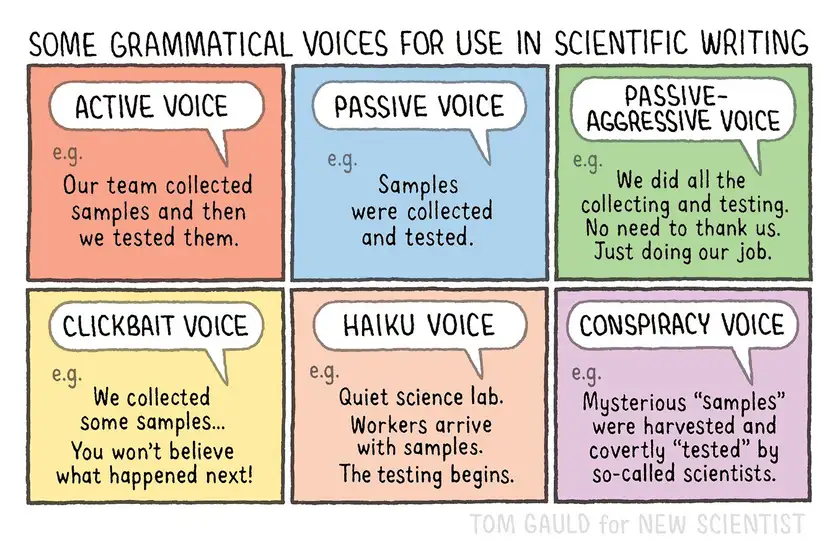Voices
« previous post | next post »
A recent cartoon by Tom Gauld:
See Geoff Pullum's list of LLOG "passive voice" posts up to 2013. Also "Mid-voice crisis: Beyond active and passive" (8/5/2017), and …
May 28, 2025 @ 3:45 pm · Filed by Mark Liberman under Linguistics in the comics
« previous post | next post »
A recent cartoon by Tom Gauld:
See Geoff Pullum's list of LLOG "passive voice" posts up to 2013. Also "Mid-voice crisis: Beyond active and passive" (8/5/2017), and …
May 28, 2025 @ 3:45 pm · Filed by Mark Liberman under Linguistics in the comics
Powered By WordPress

Cirk R. Bejnar said,
May 28, 2025 @ 5:29 pm
The first two, the traditional two verbal voices, are differentiated by verbal morphology whereas the others are marked by adverbs and so not traditionally considered specific voices, though there isn't really any reason they couldn't be in an appropriate language.
I also note that the example of Passive Voice is an actual grammatical passive and not just an academic circumloqution.
J.W. Brewer said,
May 28, 2025 @ 5:45 pm
The example of Conspiracy Voice is also an "actual grammatical passive." One piece of the Haiku Voice ("The testing begins") may be a good example of the sort of active-voice construction that's often mislabeled as passive because it feels sort of impersonal (and "vague about agency").
Laura Morland said,
May 28, 2025 @ 6:22 pm
It's clear that my mind has been primed by the Internet… my finger is hovering over "Clickbait Voice," ready to punch.
It would be delightiful if one could find Cirk R. Bejnar's suggested "appropriate language" that would actually label these voices as grammatical.
Cirk R. Bejnar said,
May 28, 2025 @ 6:58 pm
I thought I was thinking of Hopi, but a quick review of Hopi grammar doesn't reveal any interesting or unusual verbal voices or moods. There are, however, plenty listed at https://en.wikipedia.org/wiki/Grammatical_mood though they are called moods rather than voices. As I understand the categories, voice refers to how the doer of the action and/or the sufferer of it are grammatically related to the verb, whereas mood refers to how the action itself is to be understood; as a fact: indicative, as a command: imperative, etc. So a passive-aggressive, clickbait, and conspiratorial are more like moods than voices. Though how such categories are expressed is language dependent. See https://en.wikipedia.org/wiki/Tense%E2%80%93aspect%E2%80%93mood. I was specifically thinking of https://en.wikipedia.org/wiki/Evidentiality and how a https://en.wikipedia.org/wiki/Dubitative_mood isn't very different from the hypothetical Conspiracy Voice.
Chips Mackinolty said,
May 28, 2025 @ 9:07 pm
Tom Gauld deserves a medal! Perhaps a Gauld medal??
Bob Ladd said,
May 29, 2025 @ 1:36 pm
Cirk R. Bejnar's comment (together with the Tom Gauld original) reminds me of an anecdote I heard from Chas Hockett when I was a student (a *long* time ago). He was talking about the kinds of things that verbs could get inflected for – and clearly this is about moods rather than voices – and mentioned a North American language that had various ways of marking the speaker's attitude to the action described. Whoever it was that Hockett was quoting to us – someone who had worked on the language – had decided that the best names for two of these moods would be the "Godforbiditive" and the "Sowhatitive". Perhaps Tom Gauld could come up with appropriate English paraphrases.
J.W. Brewer said,
May 29, 2025 @ 2:20 pm
They may not be as overtly interesting for cocktail-party purposes as the moods, but the specialists have described and labeled plenty of different morphosyntactic voices not found in IE languages, such as the https://en.wikipedia.org/wiki/Applicative_voice, found in languages as varied as Nuxalk, Ubykh, and Ainu, and the more intriguingly-named (but conceptually similar) https://en.wikipedia.org/wiki/Circumstantial_voice, found in e.g. Malagasy.
M Skybase said,
June 1, 2025 @ 7:56 am
True, these voices may not wow at parties, but they’re linguistically fascinating. The applicative voice promotes oblique arguments (like tools or recipients) to core roles, changing verb structure. The circumstantial voice, like in Malagasy, shifts focus to elements like location or cause. Both show how languages outside Indo-European handle grammar and emphasis in ways IE languages don’t.